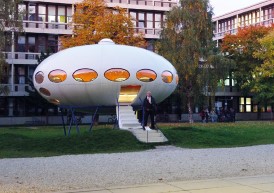History, Design and Construction in Finland and the USA
Downloads
DOI:
https://doi.org/10.52200/docomomo.66.05Keywords:
Futuro House, Matti Suuronen, Polykem Oy, FUTURO Corporation, Sandwich constructionAbstract
The Futuro by Matti Suuronen reflects the confidence in the possibilities of plastics as a new building material of post-war times. A number of the 70 to 100 Futuros that were built worldwide still exist and, generally, they are now being preserved. A comparison of four restoration approaches of Futuro Houses, dating from 2007 to 2018, has given insights into the specific constructive features, modifications and the challenge of their complex materiality and innovative design. This explains the complexity of the conservation process.
How to Cite
Published
Issue
Section
License
Copyright (c) 2022 Pamela Voigt

This work is licensed under a Creative Commons Attribution 4.0 International License.
Plaudit
References
BAYER AG. Firmenzeitschrift Farbenfabriken. Unser Werk, No 6, 1969, p. 7.
Cleworth Archive https://thefuturohouse.com/Futuro-House-Charles- Cleworth-Archive-Doc. Last visited February 29 2020.
COBBERS Arnt, JAHN, Oliver. Prefab Houses, Köln, Taschen GmbH, 2010, p. 161. According to research done by Tim Bechthold there is no proof that it was actually wrapped, only a collage exists.
Futuro house www.thefuturohouse.com. Last visited April 16 2020.
Futuro-Haus. Baugenehmigung Nr. 25/69 / v. 26.09.1969, Berlin-Treptow, GDR, 1969.
GENZEL, Elke. Zur Geschichte der Konstruktion und der Bemessung von Tragwerken aus faserverstärkten Kunststoffen 1950-1980. Dissertationsschrift. Weimar, Bauhaus-Universität Weimar, 2006.
GENZEL, Elke, VOIGT, Pamela. Kunststoffbauten: Teil 1 – Die Pioniere. Weimar, Bauhaus-Universität Weimar, 2005, p. 134.
HOME Marko, TAAMILA Mika (eds). FUTURO, Tomorrow’s House from Yesterday. Helsinki, Desura, 2002
KUITUNEN Anna-Maija. Futuro no. 001- documentation and evaluation of preservation needs. Metropolia Conservation, Historical Interiors, Bachelor’s Thesis, May 28, 2010LESLEY, Jackson. the sixties – decade of design revolution. London, PHAIDON, 1998.
STRATFORD, Oli. Farewell to the Futuro: an interview with Marko Home and Mika Taanila. Espoo, Disegno Daily September 10, 2012, p. 1.
https://www.disegnodaily.com/article/farewell-to-the-futuro-aninterview- with-marko-home-and-mika-taanila. Last visited June 9, 2019.
SUURONEN, Matti. 1983 Ansio – Ja Työluettelo. Casa Finlandia Design by Matti Suuronen SAFA Architect. Helsinki, selfpublisher, 1983
VOIGT, Pamela. Die Pionierphase des Bauens mit glasfaserverstärkten Kunststoff - 1942 bis 1980 (The pioneer era of building with glass fibre-reinforced plastics – 1942 to 1980). Dissertation. Weimar, Bauhaus-University Weimar, 2007
VOIGT, Pamela, GENZEL, Elke. Talk with Matti Suuronen and Ossi Siponen, within the research group FOMEKK at Bauhaus-Universität Weimar, (engineering office Ossi Siponen, Malminkaari 5, 00700 Helsinki) 02 June 2004, 11:30-15:00
MEZ.





